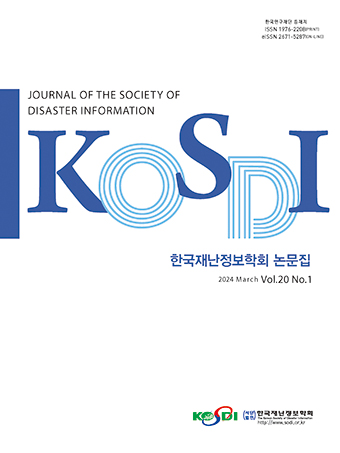Original Article
Abstract
References
Information
Purpose: In this study, since the operation principle of the CCFL Exit light is the same as that of general lighting equipment, the characteristics of the CCFL Exit light were analyzed by deriving test items that can affect the characteristics of the light source from the KS standard, which is the standard for lamp ballast performance certification of general lighting equipment. Method: The samples used in the experiment were performed on products of two manufacturers for each size, such as large, medium, and small, and the test items were power factor, crest factor, and current harmonic distortion. Result: As a result of the experiment, the power factor showed a value between 0.4 and 0.6 in all samples, which was smaller than the 0.9 value set by KS. The crest factor ranged from 3.6 to 3.7 for large, 4.4 to 4.7 for medium, and 3.5 to 3.7 for small. It showed a value more than two times higher than the KS standard of 1.7. Current total harmonic distortion ranged from 81% to 110%, and considering that the KS standard was less than 20%, it could be confirmed that all samples had a value significantly exceeding the KS standard. Conclusion: The crest factor and current total harmonic distortion may affect the temperature rise of the light source and the burnout of the device. When developing an exit light, if this item is developed within the scope of the KS standard, the quality improvement and maintenance of the exit light will be greatly improved.
연구목적: 본 연구에서는 CCFL유도등의 동작원리가 일반 조명기기와 동일하여 일반 조명기기의 램프 안정기 성능인증 기준인 KS기준에서 광원의 특성에 영향을 줄 수 있는 시험항목을 도출하여 CCFL유도등의 특성을 분석하였다. 또한 CCFL광원의 전기적 특성과 온도 특성의 연관성을 분석하여 광원 수명에 미치는 영향을 고찰하였다. 연구방법: 실험에 사용된 시료는 대형, 중형, 소형 등 각 크기별 2개 제조사의 제품을 대상으로 수행하였으며, 시험 항목은 역률, 파고율, 전류 고조파함유율이다. 연구결과: 역률은 모든 시료가 0.4~0.6사이의 값을 나타내어 KS기준에서 정한 0.9이상 보다 작은 값을 보였다. 파고율은 대형의 경우 3.6~3.7 정도의 값을 나타냈으며, 중형은 4.4~4.7, 소형은 3.5~3.7사이의 값을 나타내었다. KS기준인 1.7이하보다는 2배 이상의 높은 값을 나타냈다. 전류 고조파함유율은 81%~110%의 값을 나타냈으며, KS기준이 20% 이하임을 감안할 때 모든 시료가 KS기준을 상당히 넘어서는 값을 가짐을 확인할 수 있었다. 결론: 파고율과 전류 고조파함유율은 광원의 온도상승과 기기의 소손 등에 영향을 미칠 가능성이 있는 성분이므로 이런 전기적 특성을 KS기준의 범위 안에서 유도등을 개발한다면 유도등의 품질개선과 유지관리에 큰 도움이 되리라 생각된다.
- Han, J.-H. (2003). Design of the inverter for driving CCFL using the PAN-PZT piezoelectric transformer. Master's Thesis, Gachon University, pp. 4-6.
- Hyun, B.-C., Yun, Y.-G., Park, Y.-H, Kim, Y.-G. (2017). "Study on the direction based on audible and non-audible signals using mart devices." Journal of Korea Society of Disaster Information, Vol. 13, No. 1, pp. 51-58. 10.15683/kosdi.2017.03.31.51
- Jeon, G.-H., Kang, S.-W. (2016). "A study on development of evacuation guidance system using direction speaker and control lightning." Journal of Korea Society of Disaster Information, Vol. 12, No. 3, pp. 228-234. 10.15683/kosdi.2016.9.30.228
- Kim, H.-O. (2016). "The development and reliability validation of serveless smart exit sign system using a wireless sensor network." Master's Thesis, Yonsei University.
- Korea Agency for Technology and Standard (KATS) (2002). AC supplies electronic ballasts for fluorescent lamps(KS C 8100).
- Korea Agency for Technology and Standard (KATS) (2004). Fluorescent Lamps or General Lighting Service(KS C 7601).
- Korea Agency for Technology and Standard (KATS) (2004). Magnetic ballasts for fluorescent lamps(KS C 8102).
- Lee, D.G. (2004). Characteristics Analysis and Design of High Frequency Inverter Circuit for CCFL Drive. Master's Thesis, Dongguk University, pp. 4-6.
- Lee, T. (2013). Development of a Mobile-based Fire Evacuation System using a Wireless Network. Master's Thesis, Yonsei University.
- National Fire Agency (2018). Statistical Yearbook.
- Nation Fire Agency (2018). Standards of model approval and inspection technology for EXIT LIGHT(KOFEIS 0401).
- Publisher :The Korean Society of Disaster Information
- Publisher(Ko) :한국재난정보학회
- Journal Title :Journal of the Society of Disaster Information
- Journal Title(Ko) :한국재난정보학회논문집
- Volume : 17
- No :1
- Pages :184-193
- DOI :https://doi.org/10.15683/kosdi.2021.3.31.184




 Journal of the Society of Disaster Information
Journal of the Society of Disaster Information







